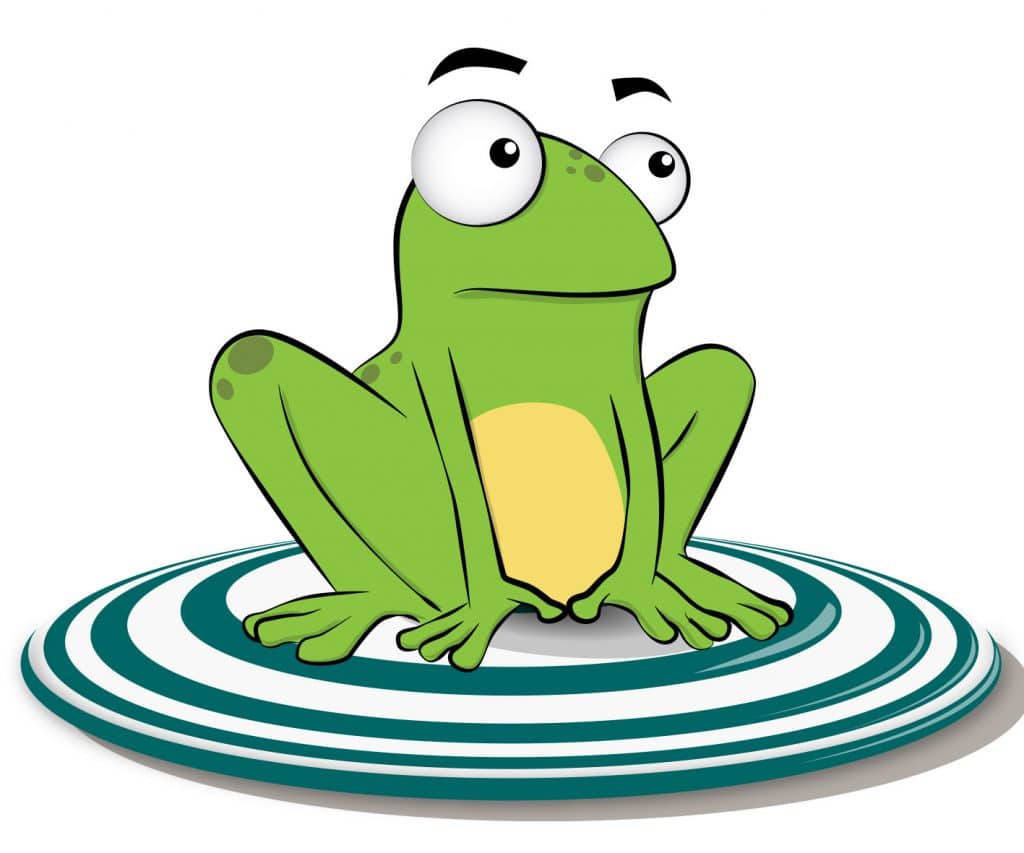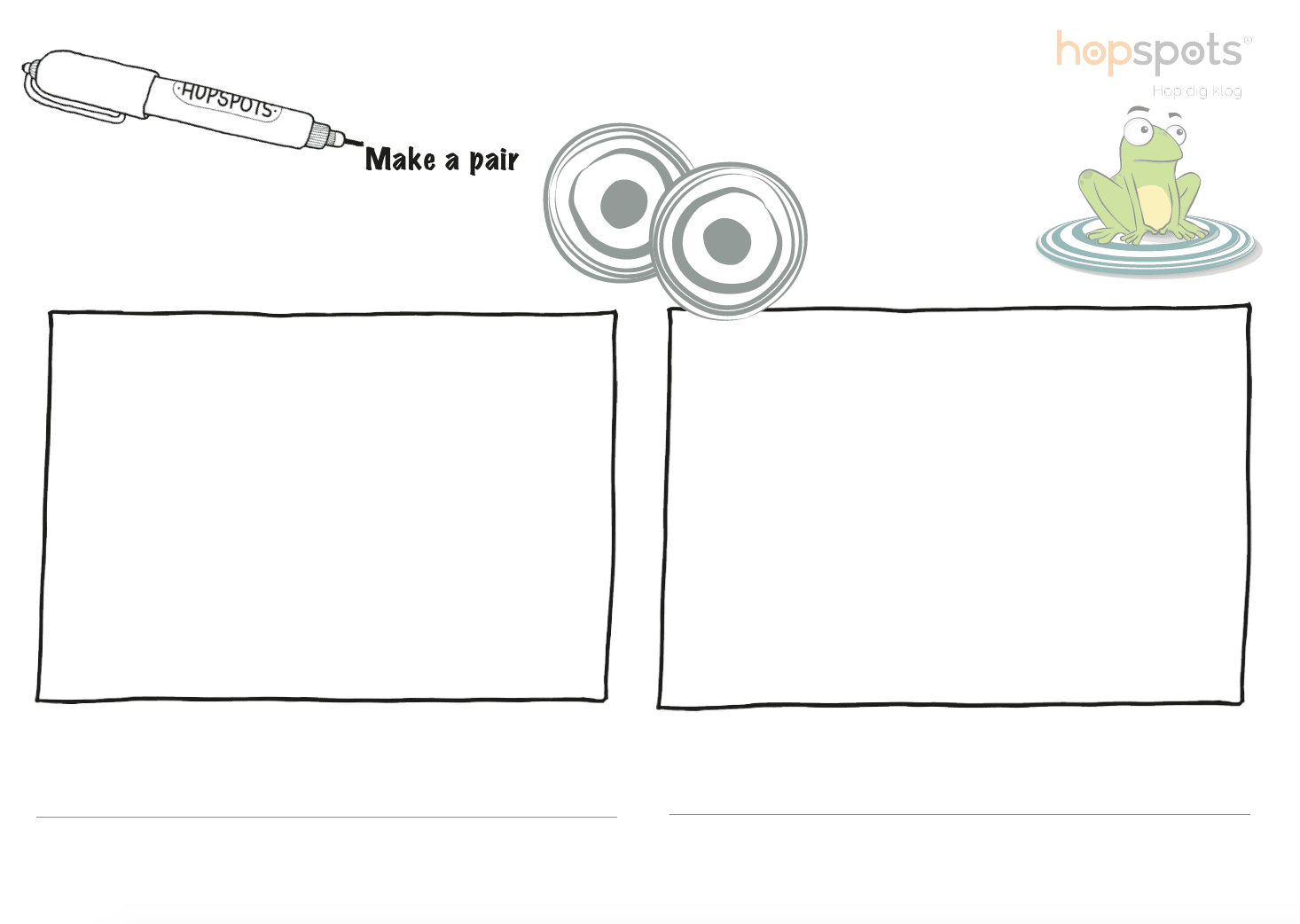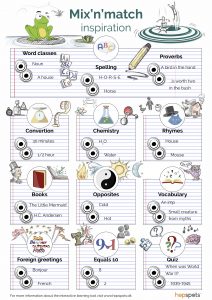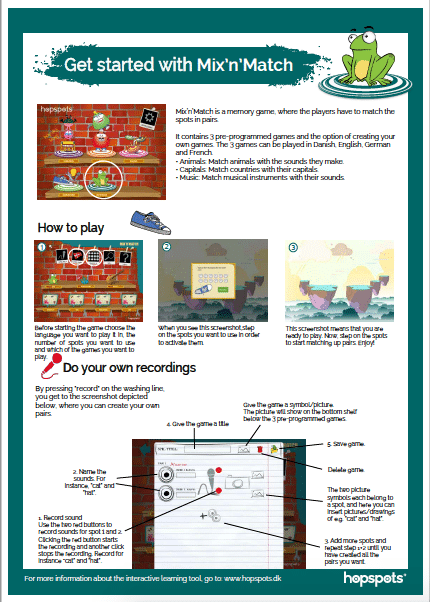MIX’N’MATCH
For all school subjects and levels
Mix’n’Match is a game where you have to match one tile with another – if you press a tile which plays a cow moo’ing, the matching tile would be the one which plays ‘cow’.
You can increase or decrease the level of difficulty when you make your own games. You can use Mix’n’Match all the way up from preschoolers to lower secondary education.
Mix’n’Match is available in Danish, English, French, and German, and you have the option to choose between the built-in games and all the games that other users have shared.

Combine learning with movement
Mix’n’Match is an active memory game that combines sounds or music with images and bodily movement and it goes a little something like this:
- The children pick a game such as matching countries with their capitals.
- They then step on random tiles and hear either the name of a capital or the name of a country and an image of the city or the country’s flag appears on the iPad-screen as well.
- The children then step on a new spot with a new sound and image. As the game progresses, the children’s goal is to remember the different spots’ corresponding capital and country to match the most pairs.
- They can keep track of how many pairs they have gotten and once there are no more tiles left, the winner can be crowned!
This exercise combines a classic memory game with spatial awareness, physical activity and collaborative play where children can help each other remember positions in order to beat it.
Video of Mix’n’Match
Become digital co-creators
It is even possible to create your own pairs! Children can easily make their own pairs and produce games for relevant school subjects and topics using the iPad.
By engaging their creativity, children can become active participants in their own education. This is a great way to stimulate engagement and maintain their attention during longer periods of teaching as their energy is directed towards a fun and interactive learning tool.
For children, gaining ownership over the teaching material provides a unique method of education whose virtues cannot be underestimated. As even the most distracted and rowdy kids can find a beneficial outlet for their energy.
Activate the entire class
You can engage the entire class all at once if you divide the class into groups that each produce games for each other.
For example, during maths lessons, one group of students can create shape cards with pictures and use Hopspots to match them with their geometrical name while another does it for fractions after which they can test each other’s knowledge of the topics.
Each group takes turns at playing the game using Hopspots while the other groups work on making more relevant games in the app. You could even make a small competition out of it to encourage the students to challenge themselves and each other.
Game topics for subjects
Maths
Mix’n’Match can also be used for a lot of different things in maths across different difficulty levels and ages. The range of applications are only limited by your own imagination and Mix’n’Match can work for almost any topic.
For example, it can be used for simple addition problems like adding up to 10, where you young children have to match two numbers that add to 10. The same can be done for subtraction or simple geometry like matching ‘3 sides’ with ‘triangle’.
For the older students, you can have a game where you have to match geometric shapes with the formula to calculate their volume or circumference.
Here are some more of our ideas as to how you could implement Mix’n’Match games in your maths class:
- Addition, Subtraction, Multiplication, and Division
- Equations
- Geometric Shapes
- Fractions
- Mathematical Formulas
English and grammar
It can also be used to great effect to help teach students the rules of grammar, spelling, word association and many more things.
For instance, you can create a game with one spot saying “H-O-R-S-E” and then the pupils’ task is to find the spot that says “Horse”, helping kids with their spelling. But there’s also great room for variation in terms of the difficulty of Mix’n’Match so you can always challenge your students with educational material that’s right for their age and ability.
You can easily create a grammar game where you have to match a word class to an example of it, such as matching “noun” with “house”. You can even use it for literature discussions where you have to match “what is a Bildungsroman?” with the correct literary description.
Here are a couple of helpful topics for playing Mix’n’Match:
- Rhymes
- Spelling
- Syntax
- Proverbs
- Antonyms
- Word classes
History, Society and Science
Mix’n’Match can be used in all school subjects and levels as you can produce your own game content.
For science subjects, it could be to match chemical compounds with their names such as “H2O” and “Water” or linking famous scientists with their discoveries like “Newton” and “Gravity”.
For History and Society subjects you can use the game to learn about new topics or repeat some that you have already been through. It could be question and answer games such as matching years with their corresponding events like “when was the Second World War?” and “1939-1945” or “in which year was the Declaration of Independence published?” and “1776”.
Second language subjects
Mix’n’Match is highly applicable for second language subjects as well. You can set the feedback in the games to be in Danish, English, German and French.
That means that if you make a game for a class in French where one spot says “présent” and you have to find the spot that says “être” to practise your grammar, you can get the feedback in French as you play, reinforcing the sound of the language.
You can make grammar, translation, question and answer games about specific topics,, and so on. It’s easy to make games where students have to match German, French or Danish words with their English counterparts such as “head” and “kopf” as a pair, and for French e.g., “Je m’appelle…” and “My name is…”.




